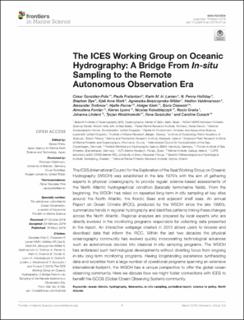| dc.contributor.author | González-Pola, César | |
| dc.contributor.author | Fratantoni, Paula S. | |
| dc.contributor.author | Larsen, Karen M.H. | |
| dc.contributor.author | Holliday, N. Penny | |
| dc.contributor.author | Dye, Stephen | |
| dc.contributor.author | Mork, Kjell Arne | |
| dc.contributor.author | Beszczynska-Möller, Agnieszka | |
| dc.contributor.author | Valdimarsson, Héðinn | |
| dc.contributor.author | Trofimov, Aleksander | |
| dc.contributor.author | Parner, Hjalte | |
| dc.contributor.author | Klein, Holger | |
| dc.contributor.author | Cisewski, Boris | |
| dc.contributor.author | Fontan, Almudena | |
| dc.contributor.author | Lyons, Kieran | |
| dc.contributor.author | Kolodziejczyk, Nicolas | |
| dc.contributor.author | Grana, Rocio | |
| dc.contributor.author | Linders, Johanna | |
| dc.contributor.author | Wodzinowski, Tycjan | |
| dc.contributor.author | Goszczko, Ilona | |
| dc.contributor.author | Cusack, Caroline | |
| dc.date.accessioned | 2020-03-25T09:01:38Z | |
| dc.date.available | 2020-03-25T09:01:38Z | |
| dc.date.created | 2019-11-07T13:15:07Z | |
| dc.date.issued | 2019 | |
| dc.identifier.issn | 2296-7745 | |
| dc.identifier.uri | https://hdl.handle.net/11250/2648486 | |
| dc.description.abstract | The ICES (International Council for the Exploration of the Sea) Working Group on Oceanic Hydrography (WGOH) was established in the late 1970's with the aim of gathering experts in physical oceanography to provide regular science-based assessments of the North Atlantic hydrographical condition (basically termohaline fields). From the beginning, the WGOH has relied on repeated long-term in-situ sampling at key sites around the North Atlantic, the Nordic Seas and adjacent shelf seas. An annual Report on Ocean Climate (IROC), produced by the WGOH since the late 1990's, summarizes trends in regional hydrography and identifies patterns linking these changes across the North Atlantic. Regional analyses are prepared by local experts who are directly involved in the monitoring programs responsible for collecting data presented in the report. An interactive webpage created in 2013 allows users to browse and download data that inform the IROC. Within the last two decades the physical oceanography community has evolved quickly incorporating technological advances such as autonomous devices into classical in-situ sampling programs. The WGOH has embraced such technological developments without diverting focus from ongoing in-situ long-term monitoring programs. Having longstanding experience synthesizing data and expertise from a large number of operational programs spanning an extensive international footprint, the WGOH has a unique perspective to offer the global ocean observing community. Here we discuss how we might foster connections with ICES to benefit the GOOS (Global Ocean Observing System) community. | en_US |
| dc.language.iso | eng | en_US |
| dc.title | The ICES Working Group on Oceanic Hydrography: A Bridge From In-situ Sampling to the Remote Autonomous Observation Era | en_US |
| dc.type | Peer reviewed | en_US |
| dc.type | Journal article | en_US |
| dc.description.version | publishedVersion | en_US |
| dc.source.volume | 6 | en_US |
| dc.source.journal | Frontiers in Marine Science | en_US |
| dc.source.issue | 103 | en_US |
| dc.identifier.doi | 10.3389/fmars.2019.00103 | |
| dc.identifier.cristin | 1744938 | |
| cristin.unitcode | 7431,20,0,0 | |
| cristin.unitname | Oseanografi og klima | |
| cristin.ispublished | true | |
| cristin.fulltext | original | |
| cristin.qualitycode | 1 | |
